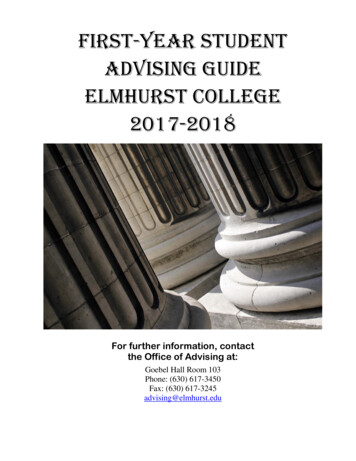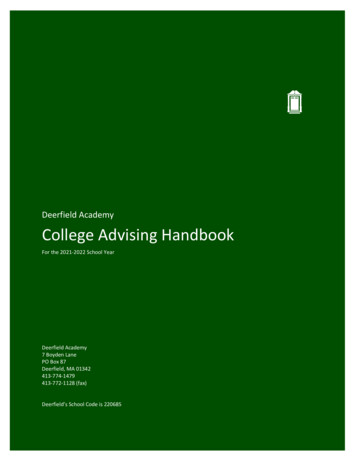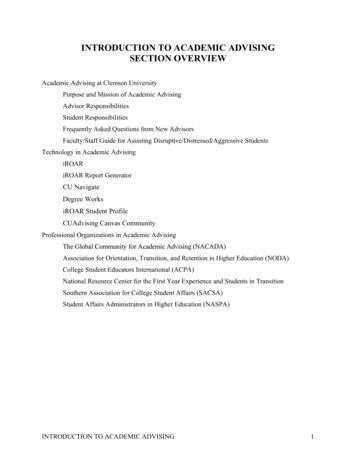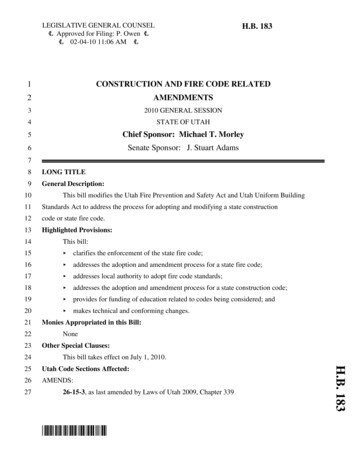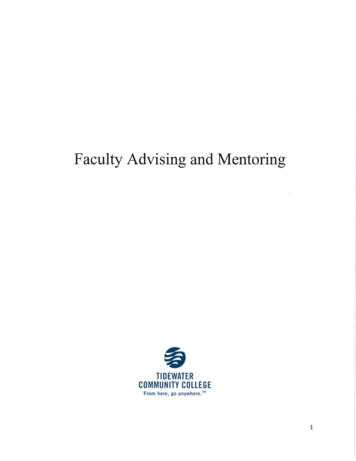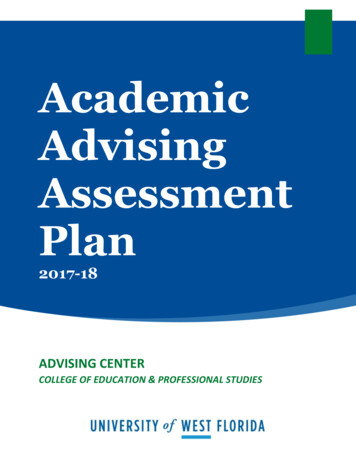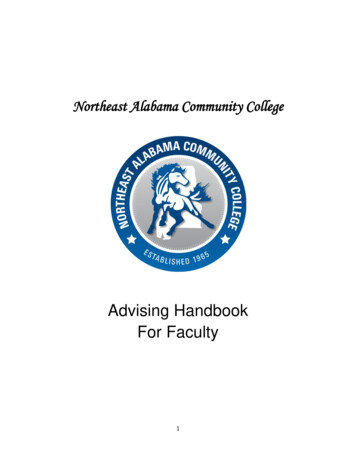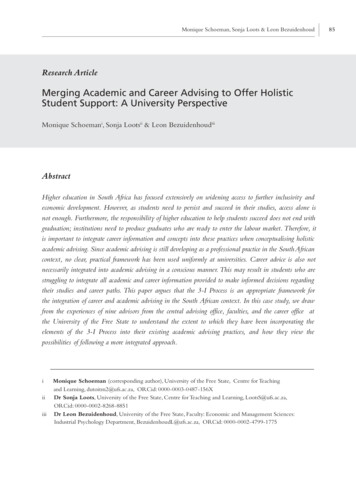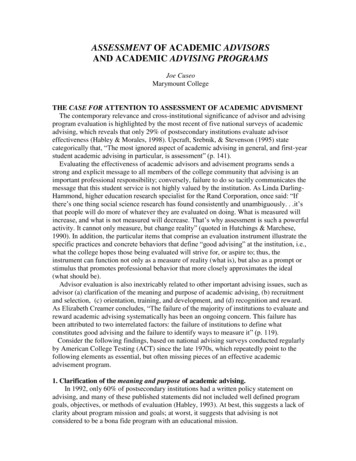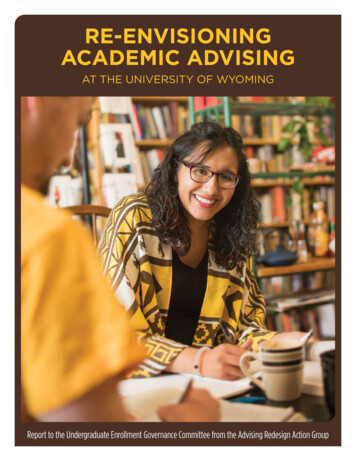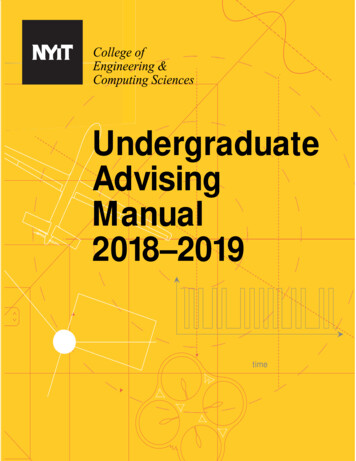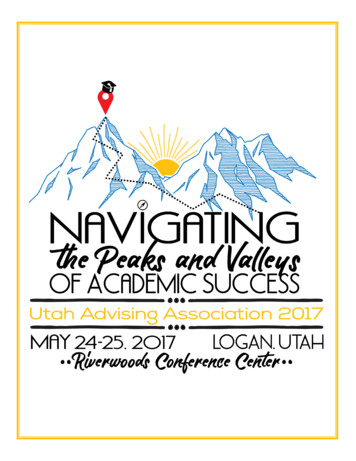
Transcription
Dear Conference Attendees:On behalf of the Utah Advising Association (UAA) Executive Committee and GoverningBoard, I would like to welcome you to the 18th annual UAA conference! This year, theUAA welcomed many new committee members. We have infused the conference withnew ideas while maintaining the traditions our predecessors created. Our boardmembers, representing the 12 major colleges and universities in the state, are excitedthat so many of you are participating in this conference in Logan, UT.The committee was inspired by the beautiful scenery of Logan, and created this year’stheme, “Navigating the Peaks and Valleys of Academic Success.” We witness studentsface challenges and achieve their goals every day as academic advisors. We hope thisconference will help you develop new tools and skills, and will provide you withnetworking opportunities that you may not be able to gain at your home institution.We would like to thank those who submitted presentation proposals. We had a recordnumber of proposal submissions this year. Due to limitation of space and time we haveduring the conference, we had to turn down many great proposals. It was very difficult,but we are confident all of the presentations as well as this year’s keynote speakers willbenefit you in many ways.It is our hope that you will enjoy this year’s conference and the beautiful city of Logan.Mayumi KasaiUniversity of Utah2016-2017 Utah Advising Association PresidentPage 1
2017UAA 2017 Conference ProgramLetter from the 2016-17 UAA President . 1History of the Utah Advising Association .3UAA Mission Statement.3Past and Present Presidents of UAA .3UAA 2016-17 Governing Board . 4UAA 2017 Conference at a Glance .5Program ScheduleDay 1 Keynote Speaker Biography (Matthew Sanders) . 10Breakout Session 1 . 11Breakout Session 2 . 12Breakout Session 3 . 12Breakout Session 4 . 13Breakout Session 5 . 14Day 2 Keynote Speaker Biography (Caren Frost) . 18Breakout Session 1 . 19Breakout Session 2 . 20Breakout Session 3 . 21Notes . 23Venue Map . Back CoverPage 2
History of the Utah Advising AssociationThe Utah Advising Association traces its origin back more than 30 years to what was known asthe Utah Advising Conference. In the beginning, there were several advising administrators throughoutthe state that thought it would be nice to gather the advisors together from their institutions for aconference to discuss advising-related issues and network with each other.Over time, this informal conference grew to include new student orientation and became a greattradition among Utah advising and orientation professionals who looked forward to gathering each yearin Park City at the Yarrow Hotel. As the number of advisors grew throughout Utah and as nearly all ofthe original conference organizers had moved on, it became clear that something must be done tomaintain this great tradition.On September 30, 1999, those serving on the conference committee voted to officially organizethe Utah Advising and Orientation Association (UAOA) and a set of bylaws were adopted that wouldensure that the opportunities for advisors in Utah would continue. Due to evolving structures among themajority of Utah higher education institutions, the UAOA governing committee voted on September 27,2013, to remove Orientation from the name of the organization to more accurately reflect those whoparticipate. Advising in Utah has never been stronger, and it is through the strength and organization ofthe Utah Advising Association (UAA) that Utah has not only maintained a valuable advising tradition,but has also hosted acclaimed regional and national conferences for the National Academic AdvisingAssociation.The key to success for the UAA has always been in the wonderful advisors located at the Collegesand Universities throughout the state. The knowledge and experience shared among these colleagueshas truly been amazing and is sure to continue indefinitely as we gather together each year.MissionThe mission of the Utah Advising Association (UAA) is to provide professional developmentopportunities for college and university personnel who serve as a part of the academic advisingcommunity. The UAA also serves as a vehicle to promote collaboration between representatives ofinstitutions throughout the state of Utah.Past & Present Presidents of the 0-20011999-2000Mayumi Kasai, University of UtahCamille Gooch, Weber State UniversityKatya Konkle, Southern Utah UniversityGale Larson, Brigham Young UniversityVicky Larsen, Utah State UniversityJennifer Wright, Weber State UniversityClint Moser, Utah Valley UniversityShanny Wilson, College of Eastern UtahTyler Morgan, LDS Business CollegeNACADA Region 10 Conference - Noelani Porter, Chair, Brigham Young UniversityBlaine Edwards, Southern Utah UniversityLee Hinckley, Utah Valley UniversitySandy McLelland, University of UtahNACADA Region 10 Conference - Debra Bryant, Chair, Dixie State CollegeNACADA National Conference - John Mortensen, Chair, Utah State UniversitySharon Aiken-Wisniewski, Weber State UniversityJohn Mortensen, Utah State UniversityWade Oliver, Salt Lake Community CollegePage 3
2017UAA 2016-2017 Governing BoardPresidentMayumi KasaiUniversity of UtahDirector of Preprofessional Advisingmkasai@advising.utah.eduPast PresidentCamille GoochWeber State UniversityAssistant Director, Student Success Centercamillegooch@weber.eduSecretary (non-voting)Juliana EspinosaUniversity of UtahCoordinator for Advisor Development and Collaborationjespinosa@advising.utah.eduUVU Administrative Representative (non-voting)Clint MoserUtah Valley UniversityAdvisement Technology Coordinatorclint.moser@uvu.eduBoard MembersCara WileyBrigham Young UniversitySupervisor, Nursing Advisement Centercara wiley@byu.eduMike OlsonDixie State UniversityDirector, Academic Advisementolson@dixie.eduTyler MorganDean of Instructional Supporttmorgan@ldsbc.eduLDS Business CollegeVerl LongSalt Lake Community CollegeAssistant Director of Academic and Career Advisingverl.long@slcc.eduJeanne TrippAcademic AdvisorSnow Collegejeanne.tripp@snow.eduMadalyn SwansonStudent Success AdvisorSouthern Utah Universitymadalynfogg@suu.eduMykel BeorchiaUtah State UniversityDirector of University Advisingmykel.beorchia@usu.eduLiz PrettymanUtah State University EasternAcademic Advising Coordinatorliz.prettyman@usu.eduWendy FarnsworthUtah Valley UniversityCulinary Arts Institute Academic Advisorculinaryarts@uvu.eduPage 4
TUESDAY, MAY 23, 20177-9 PM: Registration & Check-In (Grand Reception Hall)5:30-7:30 PM: Logan River Trail and Cobbler Evening Activity (RSVP Required)WEDNESDAY, MAY 24, 20177 AM-4 PM: Registration & Check-In (Grand Reception Hall)7 AM-4 PM: Sponsor Exhibits (Poplar and Hallway)7—8:15 AM: Breakfast Sponsored by BYU Romney Institute of Public Management (MPA)(Mahogany-Redwood)8:20-8:30 AM : Welcome & Announcements: Mayumi Kasai, 2017 President (Mahogany-Redwood)8:30-9:25 AM: Keynote Address: Matthew Sanders (Mahogany-Redwood)BREAKOUT SESSION ONE (9:40-10:30 AM)PRESENTER(S)Julie HartleyGarrett NagaishiTara IvieKatie BarnardAmy SotoTrevor WilsonMelanie BurtonSCHOOL TITLE (CODES)USHEUVUU of UBYUROOMMath Pathways RedesignWillowBack to Basics: Rethinking Strategies forFirst-Generation Student Support (B, T, M)Getting out of the Valley: Proactive Advising Strategies forUnder-performing Students (B, M, I)Navigating the Peaks and Valleys of Creating and Maintaininga Campus-Wide Advisor TrainingProgram (B, M)CottonwoodJuniperElmMapleBREAKOUT SESSION TWO (10:40-11:30 AM)PRESENTER(S)SCHOOL TITLE (CODES)ROOMWade OliverUVUPerspectives on the Future of Academic Advising(B, M)Michael PurlesJill Hoffmann-CoxSLCCWhy Won't My Student Change His Behavior? We Had a Plan!(M)CottonwoodJuniperShawna WebsterHeidi BatesMadeline MarshallTorrie FoutzDanielle KeddingtonU of UNobody Should Swim Alone - How to Create a Winning Team(B, P, I)ElmPatrice CareyBest PracticesUVUAscending the Peak or Dropping into the Valley:Helping Students Manage Transition (T, P, M, I)Theory-basedPersonal DevelopmentPage 5Advising ModelsWillowMapleInteractive
2017BREAKOUT SESSION THREE (11: 40 AM-12:30 PM)PRESENTER(S)SCHOOLTITLE (CODES)ROOMWillowKaylee RoholtRuth HarrisonUSUYour future in Academic Advising: Change it how you wantit! (B, I)Daniel JensenAmie DoepkingWSUAwkward! Communications Strategies to NavigateUncomfortable Student Appointments (B, T, P)Derek JackMonte MarshallMike RicksBYUResearch, Religion, and Resumes: Giving data-drivenInformation to Students (B, P)Kelly BrownDee-Dee Darby-DuffinU of U“I want to help people!” How to guide students in choosing atherapy career. (B)CottonwoodJuniperElmMapleLUNCH, ADVISOR OF THE YEAR AWARD, & DOOR PRIZES (12:30-2:00 PM )@ MAHOGANY-REDWOODBREAKOUT SESSION FOUR (2-2:50 PM)PRESENTER(S)SCHOOLTITLE (CODES)ROOMKeith ProctorBYUSocial Influences that Make or Break Student Success(T, P, M, I)Ashley GlennLiz LeckieU of UThere Will Be Peaks in the Valley: Using “Don’t Settle” toCombat Student Retention Myths (B, T, I)Landon PetersonJohn Van OrmanSnowHow Concurrent Enrollment Advising is AffectingStudents Entering the University (B, M)Mykel BeorchiaKara SwensonUSUTargeted Advising: Using Peer Advisors to HelpStudents Avoid Academic Crisis (B, M)WillowCottonwoodJuniperElmMapleBREAKOUT SESSION FIVE (3-3:50 PM)PRESENTER(S)SCHOOLTITLE (CODES)ROOMNiki WeightBryan OlsenUSUFinding the Trail: Strategies to Help Students Get Back onTrack to Academic Success (B)W. Kerry HammockKaren M. EvansRonald K. ChapmanShay LyonsBryan BowermanBYUTime to Walk the Talk: Developing an Internship inAcademic Advising (B)Van MangusDSUVinyasa Yoga, Deep StretchBYU Independent l Session about BYU Independent StudyMapleDINNER ON YOUR OWN ORWITH DINNER GROUP AT BULL’S HEAD GRILL(6:30 PM, RSVP REQUIRED)Best PracticesTheory-basedPersonal DevelopmentPage 6Advising ModelsInteractive
THURSDAY, MAY 25, 20177 AM-12 PM: Registration & Check-In (Grand Reception Hall)7-11 AM: Sponsor Exhibits (Poplar and Hallway)7—8:15 AM: Breakfast Sponsored by BYU Independent Study (Mahogany-Redwood)8:20-8:30 AM : Welcome & Announcements: Mayumi Kasai, 2017 President (Mahogany-Redwood)8:30-9:25 AM: Keynote: Caren Frost (Mahogany-Redwood)BREAKOUT SESSION ONE (9:40-10:30 AM)PRESENTER(S)SCHOOLTITLE (CODES)ROOMJulie PreeceScott HosfordRon ChapmanMelanie BurtonBYUBest Practices for Navigating the Peaks and Valleys of Academic Success for Students with Autism Spectrum Disorders (T, P)WillowTillie WilberSadie TsosieSeini PahuluSLCCFocus on Online Advising and Online Coaching: What have welearned, what else do we need to know? (B, I)CottonwoodJuniperJuliana EspinosaAlly HolianJennifer McLaurinU of UHooked on Assessment (B, I)Olympus Test PrepSponsorElmA Perfect Score on the GRE, a Perfect Score on the LSAT, 790out of 800 on the GMAT: Come See How a Test-Taking ExpertDemystifies Graduate Test ExamsMapleBREAKOUT SESSION TWO (10:40-11:30 AM)PRESENTER(S)SCHOOLTITLE (CODES)ROOMWillowScott HosfordJulie PreeceRon ChapmanBYUGoing the Distance: Developing Resiliency andThriving in Self and Others (P)Jared WilckenKatya KonkleSUUOur Advisors Are Total Slackers, How About Yours? (B)Jaycie MillerUSUEasternMaking the Play: Adapting to the Special Needs of the CollegeStudent-Athlete (B, M, I)Kaplan Test PrepSponsorInformation about Kaplan Test PrepCottonwoodJuniperElmMapleBREAKOUT SESSION THREE (11:40 AM-12:30 PM)PRESENTER(S)SCHOOLTITLE (CODES)ROOMSidney McGuire BrownL. Michelle TuitupouSLCCWhat's on the Menu? Helping students add careervalue to their college degrees (B, I)WillowLondon JuddRyan BraegerUSUBridge the Gap: Surveying the Retention ProgramTerrain (B, P)CottonwoodJuniperMelanee WilsonUVUAcademic Advising Approaches Cliff Notes (B, T, M)Hailey NielsonU of UElmAdvising Internationally Sponsored Students (B, T, P, I)MapleLUNCH, DOOR PRIZES, & CLOSING REMARKS (12:30-2:00 PM )@ MAHOGANY –REDWOODBest PracticesTheory-basedPersonal DevelopmentPage 7Advising ModelsInteractive
2017Page 8
Wednesday, May 242017Keynote Speaker: Dr. Matthew SandersMatt Sanders is an Associate Professor of communication studies and an AssociateDean in the College of Humanities and Social Sciences at Utah State University. Heholds a Ph.D. in communication from the University of Colorado at Boulder. Mattconducts research in the areas of student learning and empowerment as well asnonprofit organizations and social responsibility. He is the author of the bookBecoming a Learner: Realizing the Opportunity of Education that is used in first-yearexperience courses at many colleges and universities. Awards recognizing Matt’s workwith students include being named Teacher of the Year for the College of Humanitiesand Social Sciences (2010) at Utah State University; Undergraduate Research Mentorof the Year for the College of Humanities and Social Sciences (2013) at Utah StateUniversity; Certificate of Merit – Outstanding New Faculty Advisor (2011) for theNational Academic Advising Association; and the Graduate Teaching Impact Award forthe Department of Communication (2008) at the University of Colorado at Boulder.Page 10
Wednesday, May 24Day OneWelcome (Mayumi Kasai) and Keynote (Matthew Sanders) 8:20-9:25 AMnew practices that resonate with the unique needsand interests of these students at their campuses.(Codes: B, T, M)Breakout Session One9:40–10:30 AMMath Pathways RedesignJulie HartleyUtah System of Higher EducationWillowData from Utah’s public colleges and universitiesreveal that failure to successfully complete a mathclass is one of the top reasons for studentsdropping out of school before they can complete acertificate or degree. An over-reliance on CollegeAlgebra (the course with the highest failure rate) asthe general education math course of choice was amajor contributor to the problem. In response,several institutions have been redesigningQuantitative Literacy pathways to better alignstudents’ general education math class with theirmajors and career goals. This presentation willhighlight different efforts across the state toreexamine math pathways for specific majors, tolook at courses requiring College Algebra as aprerequisite, and to use career pathways or metamajors to advise students who have not yet settledon a major. It also discusses how the newemphasis on selecting College Algebra, Statistics,or Quantitative Reasoning based on potentialcareer pathways is also being implemented withConcurrent Enrollment students and theiradvisors.Back to Basics: Rethinking Strategies forFirst-Generation Student SupportGarrett Nagaishi & Tara IvieUtah Valley UniversityCottonwood-JuniperThe number of first-generation students (definedhere as students whose parents have not completeda bachelor’s degree) attending Utah colleges isincreasing. At UVU, one out of three students isfirst-gen. Yet despite the growing importance of acollege education, research consistentlydemonstrates that first-gen students are less likelyto continue on to their second year than theircontinuing-generation peers, and those who do areless likely to graduate within six years. As thispopulation grows, so does the need for a morenuanced approach to advisement that reframes thelanguage and expectations of higher education. Byexploring both qualitative and quantitativeresearch on the experiences of first-gen students atUVU, we will lay the groundwork for developingBest PracticesTheory-basedGetting out of the Valley: ProactiveAdvising Strategies for Under-performingStudentsKatie BarnardUniversity of UtahElmMany students struggling in college can get back ontrack with the assistance of their academic advisor.This session will introduce Proactive Advisingstrategies by covering two new practices developedand implemented by an Engineering department atthe U: Early Warning Grades and DepartmentalProbation Advising. This session will cover thedevelopment, implementation, and assessmentplans of these two new policies and discussadvising strategies for under-performing students.The goal is for participants to leave with a specificplan of how to work with their student populationand the session will wrap up with facilitateddiscussion and brainstorming. (Codes: B, M, I)Navigating the Peaks and Valleys ofCreating and Maintaining a Campus-WideAdvisor Training ProgramAmy Soto, Trevor Wilson, & Melanie BurtonBrigham Young UniversityMapleAdvisors are charged to help students navigate theuniversity experience with its many rules,expectations, complexities, and stresses. Thisrequires that advisors, no matter their college ordepartment, share a unified purpose. How canadvisors across campus best connect to learn aboutcampus resources and professional development tomost effectively help students? For 24 years, ourinstitution has implemented and developed anadvisor in-service training program that helpsadvisors professionalize and strengthen ouracademic advising culture. This session willprovide specific steps used to create and maintainour campus-wide advisor in-service training model.We will highlight our campus profile, in-serviceobjectives, monthly training meeting examples,communication outreach, and assessment.Attendees will brainstorm and share advisortraining ideas and leave with handouts. (Codes: B,M)Personal DevelopmentPage 11Advising ModelsInteractive
2017Wednesday, May 24advisor swimming as hard as you can to keep yourhead afloat, or you are an anchor on a large relayteam of managers and advisors, we have ideas toshare to strengthen office relationships, renewyourself, and develop your professional resources.Transforming the culture of an office to one whereeveryone feels safe to express creative solutions andmay be tough, but it is worth it! (Codes: B, P, I)Breakout Session Two10:40–11:30 AMPerspectives on the Future of AcademicAdvisingWade OliverUtah Valley UniversityWillowThis session will bring together several differentviews regarding the future of academic advising as aprofession, and the role and purpose of advising forstudents and institutions. The session will alsoinclude an overview of the current movementamong higher education institutions to recognizethe impactful role advisors can play to improvestudent success through the use of data analyticsand proactive outreach. Content for this session willbe drawn from chapters published by NACADA aswell as other recent articles and reports regardingthe role and impact of advisors.(Codes: B, M)Why Won't My Student Change HisBehavior? We Had a Plan!Michael Purles & Jill Hoffmann-CoxSalt Lake Community CollegeCottonwood-JuniperOften an advisor’s communication profile or modelis missing the critical component of empowerment.Empowerment embraces the use of tools thatinclude the different life and educational pathwaysavailable and the logical consequences of each.When student motivation is clearly understood, aplan can be developed to begin the process of goalachievement. Unfortunately, when advisors go fromasking a few questions to preparing a plan, thiscrucial empowerment step is missed. That is thecase with most coaching and communicationmodels. Many advising sessions are only helpful ifthe student is already empowered. What aboutthose that continually violate academic standards,that can’t seem to get their act together? What dothey need? Come and experience the model that willmake the difference. (Code: M)Nobody Should Swim Alone - How toCreate a Winning TeamShawna Webster, Heidi Bates, MadelineMarshall, Torrie Foutz, & Danielle KeddingtonUniversity of UtahElmAscending the Peak or Dropping into theValley: Helping Students ManageTransitionPatrice CareyUtah Valley UniversityMapleStudents face many transitions during their collegeexperience. These include academic transitions likecoming to college or choosing a major as well aspersonal transitions such as getting married orbeing diagnosed with a mental disorder. They alsoinclude non-events, like getting denied from alimited enrollment major. Advisors stand at many ofthese junctures, positioned to help . . . but do weknow how to do so effectively? This presentationexplores both Bridges and Schlossberg’s transitiontheories and will employ active participation,personal reflection, and group discussion to applythem to advising situations. By attending thispresentation, you will learn how to use transitiontheory to help students navigate the peaks andvalleys of change. (Codes: T, P, M, I)Breakout Session Three11:40 AM-12:30 PMYour future in Academic Advising: Changeit how you want it!Kaylee Roholt & Ruth HarrisonUtah State UniversityWillowIt’s often said that change is the only constant. Sothen, let’s prepare for it! In this session you’ll learnabout three change management models. You willdiscover the steps to take to set into motion changesthat you want to see happen around you. What is itthen: a change to advising practices, policies,procedures? See how advisors at Utah StateUniversity set into motion a change in the newstudent advising and registration process. Learnhow to apply a model of change with your students,in your office, with your staff, or to youradministration. Come prepare for your future inadvising. (Codes: B, I)Working in a Student Affairs office always providesample opportunities to interact with a diverse groupof people and personalities. Whether you are a loneBest PracticesTheory-basedPersonal DevelopmentPage 12Advising ModelsInteractive
Wednesday, May 24Awkward! Communications Strategies toNavigate Uncomfortable StudentAppointmentsDaniel Jensen & Amie DoepkingWeber State UniversityCottonwood-Juniperpresentation is for anyone who works with studentsabout major and career decisions. (Code: B)Have you ever been in an advising appointmentwhere the advisee does not engage in theconversation? Have you been stuck, or not sure whatto say when advisees disclose too much personalinformation? This presentation will cover helpfulcommunication strategies that will help facilitate ahealthy conversation! We will demonstrate andutilize concepts and theories from researchedcounseling approaches. Although advisors are notcounselors, there is a wealth of research informationthat can help advisors utilize effectivecommunication strategies to their advantage. Reallife advising scenarios will be used to demonstratehow these research-based strategies can helpacademic advisors navigate the awkwardness.(Codes: B, T, P)Research, Religion, and Resumes: GivingData-driven Information to StudentsDerek Jack, Monte Marshall, & Mike RicksBrigham Young UniversityElmThis session will address the growing importance ofresearch in the realm of student services. Using acase study of our own research, we’ll explain thewhy, what, and how of performing research as careeradvisement professionals. (Codes: B, P)“I want to help people!” How to guidestudents in choosing a therapy career.Kelly Brown & Dee-Dee Darby-DuffinUniversity of UtahMapleThere are many ways to help people, especiallywithin healthcare, that go beyond the obviousmedical doctor or nurse. Students may choose froma whole host of therapy careers within healthcare.The purpose of this presentation is to explain thedifference between occupational therapy, physicaltherapy and recreational therapy so that advisorscan properly guide students to the profession thatbest suits their interests and goals. We will talkabout the fundamental differences between thesethree therapy areas including scope of practice andnature of the profession. We will also provide anoverview of admissions and degree requirements foreach profession. Students come to these professionaldecisions from a myriad of majors so thisBest PracticesTheory-basedLunch, Advisor of the Year Award,Door Prizes, & Break12:30-1:50 PMBreakout Session Four2:00-2:50 PMSocial Influences that Make or BreakStudent SuccessKeith ProctorBrigham Young UniversityWillowCollege students fail to accomplish their learninggoals for a variety of reasons. However, a student’ssocial interactions with peers, parents, TA’s,professors, and advisors play a significant role inhow the student experiences and resolves theirfailures. This session explores these socialinteractions using a research-based SocialInfluences (SI) framework that was developedthrough interviews and research with strugglingstudents. The key attributes of this framework areRoles, Context, and Phases. Each attribute and itsrelationship to these failure experiences will bediscussed together with advisement strategies forexploring and assisting students to resolve theirlearning failures. Whether novice or veteran, thisinteractive session will provide participants with apowerful tool for helping students understand theirexperiences in ways that help them overcome theirfailures and accomplish their personal learninggoals. (Codes: T, P, M, I)There Will Be Peaks in the Valley: Using“Don’t Settle” to Combat StudentRetention MythsAshley Glenn & Liz LeckieUniversity of UtahCottonwood-JuniperStudent retention is becoming an increasinglyimportant commitment on campuses, and academicadvisors have become more involved in theseconversations (Nutt, 2003). Research shows thatthere are common student retention myths, whichare widely accepted. As academic advisors,committed to student success, it is important thatwe challenge student retention myths. By believingthese myths, academic advisors may be focusingtheir efforts, both financial and time, on ineffectivepractices. In this session, we will briefly discussPersonal DevelopmentPage 13Advising ModelsInteractive
2017Wednesday, May 24some of the prevailing myths in higher educationand provide research countering those myths.However, we will focus most of our time ondiscussing ways advisors can integrate the “don’tsettle” phase of appreciative advising into theiradvising practice, as an effective way to showcommitment to student success (Bloom et al, 2008)(Tinto, 1993). (Codes: B, T, I)How Concurrent Enrollment Advising isAffecting Students Entering the UniversityLandon Peterson & John Van OrmanSnow CollegeElmConcurrent Enrollment is a growing programnationwide, and Utah has consistently been a leaderin CE. This growing trend not only affects studentswhile in high school, but greatly impacts them asthey enter the university. This presentation aims tooutline ways in which concurrent enrollment isshaping how students move through the universityand how we can best service this group of students.Concurrent Enrollment advising is key inminimizing unnecessary credit, maintainingcontinuity in their education plan, and ensuring asmooth transition to on-campus life. (Codes: B, M)Targeted Advising: Using Peer Advisors toHelp Students Avoid Academic CrisisMykel Beorchia & Kara SwensonUtah State UniversityMapleStudents who are not making progress in requiredcourses may not be brought to the attention of anadvisor unless they fall in to poor academicstanding. This is especially true in STEM majorswhere not taking required prerequisites theirfreshman year could result in delaying graduation 24 semesters. Using peer advisors to analyze studentdata and reach out to students approachingacademic crisis can be an effective and efficient wayto impact student success. Creative ways to use theDisarm phase of Appreciative Advising will bediscussed. Participants will leave the session with atemplate for creating and carrying out targetedadvising projects. (Codes: B, M)Best PracticesTheory-basedBreakout Session Five3:00-3:50 PMFinding the Trail: Strategies to HelpStudents Get Back on Track to AcademicSuccessNiki Weight & Bryan OlsenUtah State UniversityWillowStudents in higher education are surrounded bymultiple challenges and struggle to overcome thembecause of low resiliency, inability to ask for help,lacking long term goals and motivation, andstruggling to develop networks of support. Atparticularly high risk are students in less than goodstanding, underprepared for college levelcoursework, and undecided students. In an effort toassist these student populations in learning toovercome obstacles, Exploratory Advising at UtahState University has developed and implemented aGrowth, Resilience, Initiative, and Tenacity (GRIT)Workshop. This presentation will discuss in depththe factors listed above and demonstrate howcomponents of the GRIT workshop teach studentsskills to overcome obstacles. Data on the outcomesof the workshop will be shown. Attendees areencouraged to participate by sharing their ownstrategies in addressing these issues. (Code: B)Time to Walk the Talk: Developing anInternship in Academic AdvisingW. Kerry Hammock, Karen M. Evans, Ronald K.Chapman, Shay Lyons, & Bryan BowermanBrigham Young UniversityCottonwood-JuniperAs the purpose and competency of academicadvisors continue to develop on Utah’s Collegecampuses there will be increasing interest in acareer in academic advising. Many advisors mayhave been asked about how they became advisors orhow students could decide if advising is a viablecareer option to consider. Over 10 yea
UVU Administrative Representative (non-voting) Clint Moser Utah Valley University clint.moser@uvu.edu Advisement Technology Coordinator Board Members Cara Wiley Brigham Young University cara_wiley@byu.edu Supervisor, Nursing Advisement Center Mike Olson Dixie State University olson@dixie.edu Director, Academic Advisement
